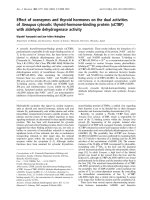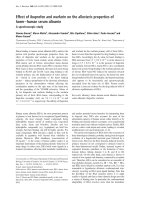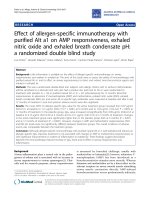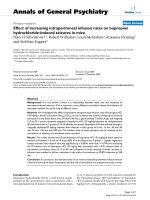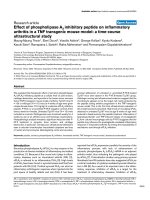Báo cáo y học: "Effect of osteopathic manipulative treatment on gastrointestinal function and length of stay of preterm infants: an exploratory study" pot
Bạn đang xem bản rút gọn của tài liệu. Xem và tải ngay bản đầy đủ của tài liệu tại đây (200.68 KB, 6 trang )
RESEARC H Open Access
Effect of osteopathic manipulative treatment on
gastrointestinal function and length of stay of
preterm infants: an exploratory study
Gianfranco Pizzolorusso
1*
, Patrizia Turi
1
, Gina Barlafante
2
, Francesco Cerritelli
1
, Cinzia Renzetti
2
,
Vincenzo Cozzolino
2
, Marianna D’Orazio
2
, Paola Fusilli
3
, Fabrizio Carinci
1
and Carmine D’Incecco
3
Abstract
Background: Organizational improvement of neonatal intensive care units requires strict monitoring of preterm
infants, inclu ding routine assessment of physiological functions of the gastrointestinal system and optimized
procedures for the definition of appropriate discharge timing.
Methods: We conducted a prospective study on the effect of osteopathic manipulative treatment in a cohort of N
= 350 consecutive premature infants admitted to a neonatal intensive care unit without any major complication
between 2005 and 2008. In addition to ordinary care, N = 162 subjects rece ived osteopathic treatment. Endpoints
of the study were differences between study and control groups in terms of excessive length of stay and
gastrointestinal symptoms, defined as the upper quartiles in the distribution of the overall population. Statistical
analysis was based on crude and adjusted odds ratios from multivariate logistic regression.
Results: Base line characteristics were evenly distributed across treated/control groups, except for the rate of infants
unable to be oral fed at admission, significantly higher among those undergoing osteopathic care (p = .03).
Osteopathic treatment was significantly associated with a reduced risk of an average daily occurrence of gut
symptoms per subject above .44 (OR = 0.45; 0.26-0.74). Gestational age lower or equal to 32 weeks, birth weight
lower or equal to 1700 grams and no milk consumption at admission were associated with higher rates of length of
stay in the unit of at least 28 days, while osteopathic treatment significantly reduced such risk (OR = 0.22;0.09-0.51).
Conclusions: In a population of premature infants, osteopathic manipulative treatment showed to reduce a high
occurrence of gastrointestinal symptoms and an excessive length of stay in the NICU. Randomized control studies
are needed to generalize these results to a broad population of high risk newborns.
Background
Significant improvements in neonatal technology utilized
in neonatal intensive care units (NICUs) over the last 2
decades, along with evidence-based care guidelines, have
significantly improved hospitalization and survival for
both low birth weight (LBW) infants and the residual
preterm population, albeit at a high cost. A major pro-
portion of pediatric hospital stays in the United States is
attribu table to neonatal conditions that rank among the
most expensive items in the list o f servi ces provided for
children [1]. The a verage cost per infant is highest for
preterm newborns with gestational age (GA) between
24-31 week s, and next highest for those between 32-36
weeks, as opposed to the general population [2]. Costs
per surviving in fant generally decrease with increasing
GA. In the United States, preterm/LBW infants account
for half the hospitalization costs of all newborns and
one quarter of overall pediatric costs [3].
Length of stay (LOS) in NICUs is strongly associated
with GA and birth weight [4]. Infants delivered at the
earliest GA have the longest hospital stays, partly because
of the h igher incidence of medical complications in very
low birth weight (VLBW) infants.
* Correspondence:
1
EBOM - European Institute for Evidence Based Osteopathic Medicine, viale
Unità d’Italia 1, 66100 Chieti, Italy
Full list of author information is available at the end of the article
Pizzolorusso et al. Chiropractic & Manual Therapies 2011, 19:15
/>CHIROPRACTIC & MANUAL THERAPIES
© 201 1 Pizzolorusso et al; licensee BioMed Central Ltd. This is an Open Access article distributed under the terms of the Creative
Commons Attribution License (http://cre ativecommons.org/licenses/by/2.0), which permits unrestri cted use, distribution, and
reproduction in any medium, provided the original w ork is properly cited.
However, compared to term infants, premature infants
are unique in their need to attain not only medical stability
but also physiologic maturity, including adequate tempera-
ture control, cessation of apnea and bradycardia, and ade-
quate feeding behavior, before they are safely discharged
to home [5,6].
Patterns of hospitalization of preterm infants are also
associated with the presence of clinical symptoms of
abnormal gastrointestinal function. In particular, vomit
and regurgitation were found to be associated with
increased esophageal acid occurrence among NICU
patients [7], as well as gastric residuals (GR) [8], which can
be linked to feeding behaviors and definitely improved by
targeted feeding strategies.
In VLBW infants, feeding tolerance algorithms are based
on pre-prandial GR volume measurement. High pre-pran-
dial volumes of GR are regarded as significant markers of
feeding intolerance [9]. Previous studies in NICUs show
that neonates under stress have a higher incidence of
stress-induced gastric mucosal damage [10,11]. Functional
constipation and hard stools are common conditions in
both term and preterm infants, usually leading to changes
in feeding formulas [12] and use of enemas in specific
settings [13].
Non invasive treatments to improve feeding tolerance
and to reduce clinical complications of premature infants
may represent a convenient option in the absence of
standard procedures for specific subgroups of patients.
The present report describes the activity of a resea rch
team investigating the effects of Osteopathic Manipulative
Treatment (OMT) in preterm infants, including monitor-
ing of physiological functions of the gastrointestinal sys-
tem and LOS.
Methods
Objective and endpoints of the study
To evaluate the efficacy of OMT on p remature infants
during hospitalization. Endpoints of the study were differ-
ences between study and control groups in terms of
changes in gastrointestinal function and LOS.
Primary endpoints were measured over the entire per-
iod of NICU hospitalization as follows:
I. High frequency of gut symptoms, defined as the
upper quartile o f the average number of epis odes of
vomit, regurgitation, GR and enema per measure-
ment visit per subject.
II. Excess duration of LOS, defined as the upper
quartile of LOS in NICU per subject.
Study Design and Population
The study was based on a non randomized, longitudinal
observational design investigating outcomes in a cohort
of newborns admitted to the NICU of the main public
hospital in Pescara, Abruzzo, Italy.
Eligible subjects included all infants consecutively
admitted between January 2005 to June 2008 (N = 663). A
total of N = 359 passed the following exclusion criteria:
GA less than 29 weeks, or greater than 37 weeks; osteo-
pathic treatment performed more than 14 days after birth;
newborn transferred to/from other hospital/unit; newborn
from an HIV seropositive and/or drug addicted mother;
newborn with any of the following clinical conditions:
genetic disorders, congenital abnormalities, cardiovascular
abnormalities, neurological disorders; proven or suspected
necrotizing enterocolitis with or without gastrointestinal
perforation; proven or suspected abdominal obstruction;
pre- and/or post- surgery patients; pneumoperitoneum
and/or atelectasis. Among the 304 subjects excluded, 232
infants had a GA below 29 or above 37, while 78 subjects
presented with severe clinical conditions.
After enrollment, 4 additio nal infants were dropped
because of an unrecorded birth weight, and 5 infants (2
from the study group; 3 from the control group) because
of complications arising during hospitalization.
The final total number of infants analyze d in this
study was 350.
A total of 188 preterm infants were non-randomly
assigned to routine neonatal care; while 162 subjects
received routine care plus OMT. All patients from both
groups were transferred from the delivery and/or oper-
ating room to the NICU immediately after birth.
No prior manipulation provided by any physical and/or
massage therapist was performed on any infant.
Data collection
Data collection was performed by undergraduate
osteopaths fro m the Accademia Italiana Osteopatia
Tradizionale (AIOT). Measurements were recorded
twice a week (Tuesdays and Fridays) based upon
NICU’sclinicalchartscompleted by nursing staff who
provided care on the same day.
Additional infant information was included: date of
birth, admission/discharge from NICU, GA at birth
(based on best obstetrical estimate), birth weight at
admission and discharge, formula and/or breast milk
intake vo lume. Gastrointestinal function was measured
as regurgitation (defined as the passage of refluxed gastric
contents into the oral pharynx), or vomiting (defined as
the expulsion of the refluxed gastric contents from the
mouth, i.e. feeding tolerance), or GR finding (milky,
bilious and bloody; measured only on infants with oro/
naso-gastric tube, recorded as present/not present), fre-
quency of stooli ng and enema administration per patient
care encounter. A neurological/developmental evaluation
at entry/discharge was not available for this study as it
Pizzolorusso et al. Chiropractic & Manual Therapies 2011, 19:15
/>Page 2 of 6
does not constitute part of routine assessment in the
NICU.
Data were directly entered on an Excel spreadsheet
Osteopathic Manipulative Treatment
Osteopathic treatment was administered to the interven-
tion group on Tuesdays and Fridays. Subjects in the
study arm received osteopathic care within 14 days after
birth, regardless of the application of any other proce-
dure (i. e. mechanical ventilation, blood transfusion or
phototherapy).
OMT was performed by a group o f osteopaths certi-
fied by the Registro degli Osteopati d’Italia with at least
five years of clinical experience.
Treatment duration ranged between 20-30 minutes.
The infant’s entire body was evaluated and manipulative
procedures were provided as indicated by the osteopathic
palpatory structural examination results. Osteopaths per-
forming OMT were trained to use only indirect and flui-
dic techniques which included: indirect myofascial,
sutural spread, balanced membranous tension and
balanced ligamentous tension (according to teachings of
William Garner Sutherland, DO, and others [14]).
Clinical procedures and discharge strategy
Feeding regimen, feeding strategies and enema administra-
tion were based on the application of standard interna-
tional guidelines to both study arms [13,15] . As distinct
from UK/US hospit als, enema prescription used by the
study NICU included five percent glucose glycerin enemas
(10:1 mixture, 5 mL/kg), administered twice a day, until
infants spontaneously expel at least 1 stool per day.
Physiological conditions required for discharge included:
maintenance of body heat at room temperature, coordi-
nated sucking, swallowing, and breathing while feeding;
sustained pattern of weight gain; and stability of cardiore-
spi ratory function (no episodes of apnea/bradycardia for
2-5 days, free of supplemental oxygen support) [6].
Statistical analysis
Main results are expressed in terms of odds ratios between
each level of a potential risk factor and a set reference
category (R.C.), with primary endpoints classified as binary
outcomes (low/high).
Potential confounders included the following charac-
terist ics (categories): gender, GA (≤ 32; > 32- ≤ 35; > 35
weeks), birth weight (≤ 1700; > 1700- ≤ 2200; > 2200
grams), oral feeding at admission (No/Yes).
Univariate statistical tests i ncluded formal tests o f the
differences between study and control groups using chi-
square for categorical variables and unpaired t-tests for
continuous measurements.
Multivariate logistic regression was used to estimate
the independent effect of OMT on primary outcomes,
simultaneously adjusting for all potential confounders.
Statistical significance was based on a probability level
(a) equal to 0.05. Results were expressed in terms of
point estimates (odds ratios: OR) and 95% confidence
intervals (C.I.). All analyses were performed using the
statistical programming language R [16].
Results
Univariate statistical analyses are shown in Table 1. No
significant imbalances were found among treated and
control groups in terms of main characteristics mea-
sured at admission, except for milk at admission (p =
0.03), showing a higher percentage of infants unable to
be oral fed at entry into t his study among those treated
with OMT.
Upper quartiles led to the definition of the following
thresholds for the outcomes of interest:
1) average daily occurrence of gut symptoms per sub-
ject above .44;
2) LOS of at least 28 days.
Results for gastrointestinal function are shown in
Table 2. None of the risk factors considered as potential
correlates were found to be associated with an high rate
of gut symptoms, except for OMT (OR = 0.45;0.27-
0.74). Multivariate logistic regression confirmed OMT
to be independently associated with a 55% reduction of
gastrointestinal symptoms ( Adjusted OR = 0.4 5;0.26-
0.74).
Results for LOS are reported in Table 3. Univariate
odds ratios showed the following categories to be asso-
ciated with increased rates of LOS equal or above 28
Table 1 General characteristics of the study population
Study Group Control Group p value
N 162 (46.3) 188 (53.7)
Gender
Females 81 (50.0) 89 (47.3)
Males 81 (50.0) 99 (52.7) 0.70
Gestational Age
≤ 32 39 (24.1) 43 (22.9)
> 32, ≤ 35 69 (42.6) 72 (38.3)
> 35 54 (33.3) 73 (38.8) 0.56
Weight (grams)
At Birth
≤ 1700 27 (16.7) 36 (19.2)
> 1700, ≤ 2200 62 (38.3) 63 (33.5)
> 2200 73 (45.0) 89 (47.3) 0.62
At Admission* 2148 (486.7) 2212 (562.3) 0.25
Oral feeding at admission
No 129 (79.6) 129 (68.6)
Yes 33 (20.4) 59 (31.4) 0.03
Numbers in Table are N (%), p values from Chi Square test
* = mean, (standard deviation); p value from t test
Pizzolorusso et al. Chiropractic & Manual Therapies 2011, 19:15
/>Page 3 of 6
days: GA ≤ 32 weeks (OR = 38.10;16.40-88.20; R.C.:GA
> 35 weeks), birth weight ≤ 1700 gm vs > 2200 gm (OR
= 120.60;42.70-340.60) and birth weight > 1700 gm, ≤
2200 gm (OR = 5.80;2.40-13.80; R.C.: birth weight >
2200 gm), o ral feeding at admission (OR = 2.85;1.44-
5.66) and OMT (OR = 0.51 ;0.30-0.85). Multivariate
logistic regression showed similar patterns, confirming
an independent effect of OMT, simultaneously adjusted
Table 2 Results for Average Daily Gut Symptoms: Crude and Adjusted Odds Ratios from Multivariate Logistic
Regression
Average Daily Gut Symptoms* Univariate O.R. Adjusted O.R
≤ 0.44 > 0.44 O.R. (95%CI) p > |c
2
O.R. (95%CI) p > |c
2
N 262 (74.9) 88 (25.1)
Gender
Females [R.C] 129 (75.9) 41 (24.1) 1 - 1 -
Males 133 (73.9) 47 (26.1) 1.11 (0.68-1.80) 0.759 1.08 (0.65-1.79) 0.777
Gestational Age
≤ 32 57 (69.5) 25 (30.5) 1.20 (0.65-2.21) 0.670 1.02 (0.43-2.40) 0.965
> 32, ≤ 35 112 (79.4) 29 (20.6) 0.71 (0.40-1.25) 0.293 0.72 (0.39-1.32) 0.292
> 35 [R.C] 93 (73.2) 34 (26.8) 1 - 1 -
Birth Weight (grams)
≤ 1700 39 (67.2) 19 (32.8) 1.54 (0.80-2.96) 0.265 1.39 (0.55-3.46) 0.481
> 1700, ≤ 2200 100 (76.9) 30 (23.1) 0.95 (0.55-1.63) 0.952 1.03 (0.55-1.93) 0.927
> 2200 [R.C] 123 (75.9) 39 (24.1) 1 - 1 -
Oral feeding at admission
No 192 (74.4) 66 (25.6) 1.09 (0.63-1.90) 0.860 1.18 (0.67-2.13) 0.583
Yes [R.C] 70 (76.1) 22 (23.9) 1 - 1 -
OMT
No [R.C] 128 (68.1) 60 (31.9) 1 - 1 -
Yes 134 (82.7) 28 (17.3) 0.45 (0.27-0.74) 0.002 0.45 (0.26-0.74) 0.002
R.C. = Reference Category
* No. of episodes of Vomit, Regurgitation, Gastric residual and Enema
Table 3 Results for Length of Stay (LOS): Crude Odds Ratios (p value from Cochran Mantel Haenszel Chi Square Test
of Zero Correlation) and Adjusted Odds Ratios from Multivariate Logistic Regression (p value from partial test on
regression coefficient)
LOS (days) Univariate O.R. Adjusted O.R.
<28 ≥ 28 O.R. (95%CI) p > |c
2
O.R. (95%CI) p > |c
2
N 267 (76.3) 83 (23.7)
Gender
Females [R.C] 128 (75.3) 42 (24.7) 1 - 1 -
Males 139 (77.2) 41 (22.8) 0.90 (0.55-1.47) 0.765 1.40 (0.63-3.10) 0.412
Gestational Age
≤ 32 21 (25.6) 61 (74.4) 38.10 (16.40-88.20) < 0.001 10.90 (3.53-33.72) < 0.001
> 32, ≤ 35 128 (90.8) 13 (9.2) 1.33 (0.55-3.22) 0.680 0.76 (0.27-2.15) 0.609
> 35 [R.C] 118 (92.9) 9 (7.1) 1 -
Birth Weight (grams)
≤ 1700 9 (15.5) 49 (84.5) 120.60 (42.70-340.60) < 0.001 43.23 (11.63-160.66) < 0.001
> 1700, ≤ 2200 103 (79.2) 27 (20.8) 5.80 (2.40-13.80) < 0.001 3.01 (1.05-8.68) 0.041
> 2200 [R.C] 155 (95.7) 7 (4.3) 1 - 1 -
Oral feeding at admission
No 186 (72.1) 72 (27.9) 2.85 (1.44-5.66) 0.003 3.11 (1.05-9.25) 0.041
Yes [R.C] 81 (88.0) 11 (12.0) 1 - 1 -
OMT
No [R.C] 133 (70.7) 55 (29.3) 1 - 1 -
Yes 134 (82.7) 28 (17.3) 0.51 (0.30-0.85) 0.012 0.22 (0.09-0.51) < 0.001
R.C. = Reference Category
Pizzolorusso et al. Chiropractic & Manual Therapies 2011, 19:15
/>Page 4 of 6
for all factors, corresponding to more than a 75% reduc-
tion in excessive LOS (Adjusted OR = 0.22;0.09-0.51)
Discussion
The main objective of this exploratory study was to
investigate the effects of OMT in a population of pre-
mature infants in terms of gastrointestinal functions and
LOS.
The medical literature lacks information of any potential
benefits of complementary treatments in this area. To the
best of the authors’ knowledge, OMT in premature new-
borns has never been documented by pediatric specialty
journals. Studies carried out in pediatric patients suggested
positive effects of OMT in very young children [17-19]. In
the broader field of manual therapy, specialists of massage
therapy and kinesthetic stimulation showed positive
results in premature infants [20]. However, such findings
were inconsistent and obtained with heterogeneous meth-
ods, showing only minimal differences in terms of clinical
significance [20,21].
The present study suggests that OMT may red uce the
occurrence of frequent symptoms of abnorma l gastroin-
testinal functionality.
Precise mechanisms for such positive effects generated
by OMT are difficult to specify, but several hypotheses
can be offered on the basis of neurological, tissue and
neuroendocrine factors.
In terms of neurology, there is evidence of an associa-
tion between autonomic nervous system function and
OMT, showing a significant direct relation between
myofascial release technique and modifications in the
autonomic nervous system activity [22].
Regarding the interaction between OMT and tissue
modification, in-vitro models highlight a possible decrease
in the production of inflammatory factors [23].
A possible role of neuroendocrine factors can be
hypothesized as indicated by the evidence of the effect of
OMT on pain biomarker modification in patients affected
by low back pain [24].
Thisstudyalsoshowsthatasignificantlyhigherrate
of premature infants receiving osteopathic care can be
discharged before 28 days regardless of gender, GA,
birth weight and oral feeding at admission.
Such a result m ay have important implications for the
optimization of health care in premature infants. Focusing
on the percentage of patients discharged before a given
threshold, rather than looking at the average reduction in
LOS, may be ve ry relevant for health o ptimization and
cost control. Reducing the rate of long stays would reduce
the number of patients in the NICU, allowing for more
cribs to become simultaneously available for those infants
who require specialized care.
From an epidemiological point of view, t he potential
benefit may also spread be yond discharge, consi dering
that hospitalization can influence nutrition [25] and
morbidity of gastrointestinal infections [26].
An understanding of the differential advantage of OMT
on specific subgroups, in particular within specified classes
of GA, will require ad hoc studi es with an adequate sam-
ple size. In the present study, it was not possible to per-
form subgroups analyses on subjects with v ery low GA,
due to the very limited number of patients available for
enrollment.
Finally, some i ntrinsic limitations of the present study
need to be outlined.
This report is based on measurements implemented at
the local NICU at the start of the study. Additional rele-
vant confounding variables such as maternal/delivery
factors (including breast feeding), r espiratory support,
method of feeding and gastric emptying time could not
be included in this study.
Treatment allocation was neither randomized nor struc-
tured, as it was based on matters of convenience within
the constraints of the proposed two days per week of
osteopathic care. Furthermore, due to the current logistics
and procedures it was not possible to “blind” nurses and
neonatologists to treatment regimen.
This study, which was conducted in only one NICU,
cannot capture the intrinsic variability of organizational
strategies a cross multiple clinical c enters managing the
complexities of the overall population of newborn
infants.
From a methodological point of view, sample size was
not based on formal power estimation, treatment was not
allocated using a random procedure, and the population
of preterm infants may not be representative of the entire
population of cases.
The above limitations affect our ability to check for bias
and duly rely on the precision of our estimates. In other
terms, both the size of the effect of OMT (point estimate)
and its level of uncertainty (95% confidence interval) are
more likely to be inconsistent with further results obtain-
able under more general conditions.
To evaluate the efficacy of OMT more studies are
required using formal experimental methods, such as ran-
domized and placebo controlled clinical trials. The best
endpoint of a well designed three armed study would be
the difference between the sham and the actual treatment.
However, to make it possible, osteopaths should collabo-
rate with NICU managers to revise the application of
operational procedures, so that OMT can be smoothly
applied on large populations, across multiple clinical sites.
Despite the above limitations, and given the current
lack of info rmation on the possible effects o f OMT in
preterm infants, the finding of this report sets an interest-
ing ground for new developments. Among these, the
standard measurement of all relevant parameters repre-
sents an essential aspect that deserves attention for future
Pizzolorusso et al. Chiropractic & Manual Therapies 2011, 19:15
/>Page 5 of 6
investigati ons. Key characteristics and outcomes that can
be easily monitored on a daily basis b y clinicians, nurses
and even pa rents of preterm infants have been identified.
Their adoption for the construction of electronic data
base registers can offer a sustainable means to improve
both analysis and management of NICU activity, allowing
to carry out more detailed exploratory studies while pro-
viding a basis for ongoing trials.
Conclusion
The study suggests that osteopathic treatment may
reduce a high occurrence of gastrointestinal symptoms
and the rates of long-term stays.
Randomized control studies are needed to confirm
these results and to gener alize them to a broader popu-
lation of high risk newborns.
Abbreviations
NICU: neonatal intensive care unit; VLBW: very low birth weight; LBW: low
birth weigh; GA: gestational age; LOS: length of stay; GER: gastroesophageal
reflux; GR: gastric residual; OMT: osteopathic manipulative treatment; OR:
odd ratio.
Author details
1
EBOM - European Institute for Evidence Based Osteopathic Medicine, viale
Unità d’Italia 1, 66100 Chieti, Italy.
2
AIOT - Accademia Italiana Osteopatia
Tradizionale, via Prati 29, 65124 Pescara, Italy.
3
Unità di Terapia Intensiva
Neonatale - Ospedale Civile Spirito Santo, Via Renato Paolini 45, 65124
Pescara, Italy.
Authors’ contributions
GB and CD conceived the idea of the study. GP, GB, VC, CR and FCE
participated in the design of the study and its coordination. GP, PT, MD, FCE
and PF coordinated and performed the data collection. GP and FCA drafted
the manuscript. FCA performed the statistical analysis. All authors read and
approved the final manuscript.
Competing interests
The authors declare that they have no competing interests.
Received: 16 November 2010 Accepted: 28 June 2011
Published: 28 June 2011
References
1. Owens PL, Thompson J, Elixhauser A, Ryan K: Care of Children and
Adolescents in U.S. Hospitals.Edited by: Rockville, MD. Agency for
Healthcare Research and Quality; 2003:, Report HCUP Fact Book No. 4;
AHRQ Publication 04-0004.
2. Clements KM, Barfield WD, Ayadi MF, Wilber N: Preterm birth-associated
cost of early intervention services: an analysis by gestational age.
Pediatrics 2007, 119(4):e866-74, Epub 2007 Mar 5.
3. Russell RB, Green NS, Steiner CA, Meikle S, Howse JL, Poschman K, Dias T,
Potetz L, Davidoff MJ, Damus K, Petrini JR: Cost of hospitalization for
preterm and low birth weight infants in the United States. Pediatrics
2007, 120(1):e1-9.
4. Bakewell-Sachs S, Medoff-Cooper B, Escobar GJ, Silber JH, Lorch SA: Infant
functional status: the timing of physiologic maturation of premature
infants. Pediatrics 2009, 123(5):e878-86.
5. Eichenwald EC, Blackwell M, Lloyd JS, Tran T, Wilker RE, Richardson DK:
Inter-neonatal intensive care unit variation in discharge timing: influence
of apnea and feeding management. Pediatrics 2001, 108(4):928-33.
6. American Academy of Pediatrics: Hospital discharge of the high-risk
neonate–proposed guidelines. Pediatrics 1998, 102:411-7.
7. Mezzacappa MA, Rosa AC: Clinical predictors of abnormal esophageal pH
monitoring in preterm infants. Arq Gastroenterol 2008, 45(3):234-8.
8. Mihatsch WA, von Schoenaich P, Fahnenstich H, Dehne N, Ebbecke H,
Plath C, von Stockhausen HB, Muche R, Franz A, Pohlandt F: The
significance of gastric residuals in the early enteral feeding
advancement of extremely low birth weight infants. Pediatrics 2002,
109(3):457-9.
9. Bertino E, Giuliani F, Prandi G, Coscia A, Martano C, Fabris C: Necrotizing
enterocolitis: risk factor analysis and role of gastric residuals in very low
birth weight infants. J Pediatr Gastroenterol Nutr 2009, 48(4):437-42.
10. Mäki M, Ruuska T, Kuusela AL, Karikoski-Leo R, Ikonen RS: High prevalence
of asymptomatic esophageal and gastric lesions in preterm infants in
intensive care. Crit Care Med 1993, 21(12):1863-7.
11. Kuusela AL, Mäki M, Ruuska T, Laippala P: Stress-induced gastric findings
in critically ill newborn infants: frequency and risk factors. Intensive Care
Med 2000, 26(10):1501-6.
12. Duman N, Utkutan S, Ozkan H, Ozdoğan S: Are the stool characteristics of
preterm infants affected by infant formulas? Turk J Pediatr 2000,
42(2):138-44.
13. Mihatsch WA, Franz AR, Högel J, Pohlandt F: Hydrolyzed protein
accelerates feeding advancement in very low birth weight infants.
Pediatrics 2002, 110(6):1199-203.
14. Magoun HI: Osteopathy in the Cranial Field.Edited by: Kirksville, Mo.
Journal Printing Co; , 3 1976.
15. Nutrition Toolkit: 2008 [ />Accessed June 24th 2010.
16. The R Development Core Team, R: A Language and Environment for
Statistical Computing. [ />Accessed June 24th 2010.
17. Hayden C, Mullinger B: A preliminary assessment of the impact of cranial
osteopathy for the relief of infantile colic. Complement Ther Clin Pract
2006, 12(2):83-90.
18. Vandenplas Y, Denayer E, Vandenbossche T, Vermet L, Hauser B,
Deschepper J, Engelen A: Osteopathy may decrease obstructive apnea in
infants: a pilot study. Osteopath Med Prim Care 2008, 19(2):8.
19. Philippi H, Faldum A, Schleupen A, Pabst B, Jung T, Bergmann H, Bieber I,
Kaemmerer C, Dijs P, Reitter B: Infantile postural asymmetry and
osteopathic treatment: a randomized therapeutic trial. Dev Med Child
Neurol 2006, 48(1):5-9.
20. Massaro AN, Hammad TA, Jazzo B, Aly H: Massage with kinesthetic
stimulation improves weight gain in preterm infants. J Perinatol 2009,
29(5):352-7.
21. Vickers A, Ohlsson A, Lacy JB, Horsley A: Massage for promoting growth
and development of preterm and/or low birth-weight infants. Cochrane
Database Syst Rev 2004, 2: CD000390, Review.
22. Henley CE, Ivins D, Mills M, Wen FK, Benjamin BA: Osteopathic
manipulative treatment and its relationship to autonomic nervous
system activity as demonstrated by heart rate variability: a repeated
measures study. Osteopath Med Prim Care 2008, 5(2):7.
23. Meltzer KR, Standley PR: Modeled repetitive motion strain and indirect
osteopathic manipulative techniques in regulation of human fibroblast
proliferation and interleukin secretion. J Am Osteopath Assoc 2007,
107(12):527-36.
24. Degenhardt BF, Darmani NA, Johnson JC, Towns LC, Rhodes DC, Trinh C,
McClanahan B, DiMarzo V: Role of osteopathic manipulative treatment in
altering pain biomarkers: a pilot study. J Am Osteopath Assoc 2007,
107(9):387-400.
25. Kirchner L, Jeitler V, Waldhör T, Pollak A, Wald M: Long hospitalization is
the most important risk factor for early weaning from breast milk in
premature babies. Acta Paediatr 2009, 98:981-984.
26. Kramer MS, Kakuma R: Optimal duration of exclusive breastfeeding.
Cochrane Database Syst Rev 2002, , 1: CD003517.
doi:10.1186/2045-709X-19-15
Cite this article as: Pizzolorusso et al.: Effect of osteopathic manipulative
treatment on gastrointestinal function and length of stay of preterm
infants: an exploratory study. Chiropractic & Manual Therapies 2011 19:15.
Pizzolorusso et al. Chiropractic & Manual Therapies 2011, 19:15
/>Page 6 of 6
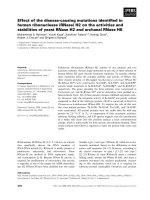
![Báo cáo Y học: Effect of adenosine 5¢-[b,c-imido]triphosphate on myosin head domain movements Saturation transfer EPR measurements without low-power phase setting ppt](https://media.store123doc.com/images/document/14/rc/vd/medium_vdd1395606111.jpg)
